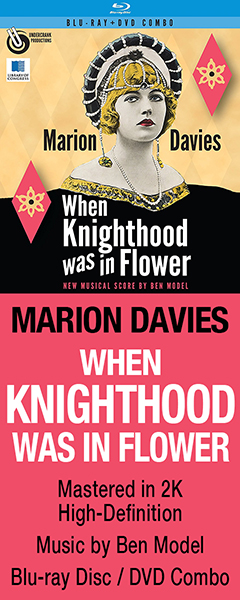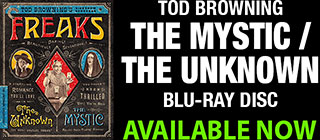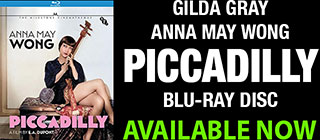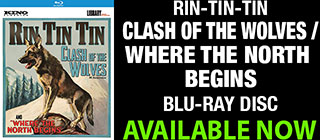Silent Era Home Page > Home Video > Seven Chances

Reviews of silent film releases on home video.
Copyright © 1999-2024 by Carl Bennett
and the Silent Era Company.
All Rights Reserved. |
|
Seven Chances
(1925)
|
One of his most-successful comedies, Seven Chances (1925) features Buster Keaton as Jimmie Shannon, a man who must be married in less than a day in order to inherit a large fortune. Unfortunately, his true love (Ruth Dwyer) and several other ‘first choices’ (the seven chances — in reality Hollywood starlets identified in the film by name) turn him down flatly. Seemingly hopeless, Buster’s misfortune gets worse as a newspaper story, placed by his well-meaning business partner (T. Roy Barnes), informs the public of his inheritance situation producing a flood of would-be brides that turn aggressive in their matrimonial competition.
Among the memorable gags is an extended sequence, created by accident, with Buster chased down a hillside by a number of small to enormous boulders. During a preview showing Buster noted that a gag sequence of him running away from the brides downhill was falling flat, until the audience saw him briefly running away from rolling rocks that he had accidently dislodged from the hillside. Director Buster went back into production, shooting an extension to the sequence with myriad prop boulders chasing him, and ultimately the brides, away.
The film’s story was the basis for the limp Chris O’Donnell and Renée Zellweger comedy, The Bachelor (1999).
— Carl Bennett
|
 Kino Classics Kino Classics
2011 Blu-ray Disc edition
Seven Chances (1925), color-toned black & white and color, 87 minutes, not rated.
Kino Lorber, K843, UPC 7-38329-08432-5.
One single-sided, single-layered, Region 0 Blu-ray Disc, 1.33:1 aspect ratio image in pillarboxed 4:3 (1920 x 1080 pixels) progressive scan AVC (MPEG-4) format, SDR (standard dynamic range), ? Mbps average video bit rate, ? Kbps audio bit rate, DTS-HD 5.1 surround sound and LPCM 2.0 stereo sound, English language intertitles, no foreign language subtitles; 10 chapter stops; standard BD keepcase in cardboard slipcase; $34.95.
Release date: 13 December 2011.
Country of origin: USA
Ratings (1-10): video: 10 / audio: 9 / additional content: 8 / overall: 9.
|

This Blu-ray Disc edition has been transfered from high-quality 35mm nitrate print materials held by the Library of Congress, as licensed by the new owner of the Raymond Rohauer collection, Cohen Film Collection LLC.
The camera negatives for the opening Technicolor sequence have been lost, but it is presented here from the best available surviving 35mm print materials. The sequence has been digitally composited to render as clear and faithful a representation of the original color as is possible today. The remainder of the film is presented in a conservatively brown (rather than orange) sepia-toned picture (which will appear as slightly brownish to nearly black & white, depending on the color settings of your system) featuring of the high quality of image detail we had always hoped we could see from the surviving prints. The high-definition video transfer does still show much of the source print’s fine speckling, dust and other flaws — but, honestly, we don’t care. The results are stunning . . . especially when compared to the hard-to-find small company VHS videotape editions of just 20 years ago.
The film is accompanied by the same excellent music score by Robert Israel, performed on piano, woodwinds and strings (with an extended theater organ sequence), that accompanied Kino’s previous DVD edition from 2000 and their 1990s home video editions issued on laserdisc and VHS videotape. The score still sounds great after having been reprocessed for 5.1 surround sound, and we are happy that it is still associated with the best available home video editions of the film.
Among the supplemental material is audio commentary by Bruce Lawton and Ken Gordon, an examination of the Technicolor sequence in Seven Chances by Eric Grayson, a video essay on Keaton locations by John Bengtson, a production photo gallery, the Edison short How a French Nobleman Got a Wife Through the New York Herald Personal Columns (1904), and a complete presentation of the Three Stooges in Brideless Groom (1947).
The Grayson Technicolor supplement is intriguing as it gives us a simultaneous look at the Library of Congress black & white preservation print, a new HD transfer of the nitrate Technicolor print (now faded almost completely to orange-red) held by the Library of Congress, a baselight color-corrected HD version and a digitally composited combination of the black & white print with color elements to achieve the closest approximation of original Technicolor release prints. The short supplemental section gives us an idea of what went into the more than 80 hours of digital work to achieve the high-definition Technicolor sequence presented in this edition.
This new Kino edition is such an improvement over the already excellent home video master produced by David Shepard in 1995 that we enthusiastically recommend this Blu-ray Disc edition to every silent film collector with a BD player and an HD monitor. What a pleasure to watch!
|
|
USA: Click the logomark to purchase this Region 0 Blu-ray Disc edition from Amazon.com. Your purchase supports Silent Era.
|

|
|
|
Canada: Click the logomark to purchase this Region 0 Blu-ray Disc edition from Amazon.ca. Your purchase supports Silent Era.
|

|
|
 Kino Classics Kino Classics
2012 Blu-ray Disc edition
The Ultimate Buster Keaton Collection (1920-1937), black & white, 1600 minutes total, not rated,
including Seven Chances (1925), color-toned black & white and color, 87 minutes, not rated.
Kino Lorber, K1087, UPC 7-38329-10872-4.
Fourteen single-sided, dual-layered, Region 0 Blu-ray Discs, 1.33:1 aspect ratio image in pillarboxed 16:9 (1920 x 1080 pixels) progressive scan AVC (MPEG-4) format, SDR (standard dynamic range), ? Mbps average video bit rate, ? kbps audio bit rate, ? Mbps average video bit rate, ? kbps audio bit rate, Dolby Digital 2.0 stereo sound, English language intertitles, no foreign language subtitles; 10 chapter stops; four multidisc BD cases in cardboard slipcase; $299.95.
Release date: 11 December 2012.
Country of origin: USA
|

This Blu-ray Disc boxset contains the high-definition home video release of Buster Keaton’s Seven Chances.
This boxset edition of Seven Chances is identical to Kino’s single-disc Blu-ray Disc edition noted above.
|
|
USA: Click the logomark to purchase this Region 0 Blu-ray Disc edition from Amazon.com. Your purchase supports Silent Era.
|

|
|
|
Canada: Click the logomark to purchase this Region 0 Blu-ray Disc edition from Amazon.ca. Your purchase supports Silent Era.
|

|
|
|
United Kingdom: Click the logomark to purchase this Region 0 Blu-ray Disc edition from Amazon.co.uk. Support Silent Era.
|

|
|
 Kino Classics Kino Classics
2011 DVD edition
Seven Chances (1925), color-toned black & white and color, 87 minutes, not rated.
Kino Lorber, unknown catalog number, unknown UPC number.
One single-sided, dual-layered, Region 0 NTSC DVD disc, 1.33:1 aspect ratio image in full-frame 4:3 (720 x 480 pixels) interlaced scan MPEG-2 format, SDR (standard dynamic range), ? Mbps average video bit rate, ? kbps audio bit rate, Dolby Digital 2.0 stereo sound, English language intertitles, no foreign language subtitles, chapter stops; standard DVD keepcase; $29.99.
Release date: 13 December 2011.
Country of origin: USA
Ratings (1-10): video: 9 / audio: 9 / additional content: 8 / overall: 9.
|
|
This remastered DVD edition has been transfered from high-quality 35mm nitrate print materials held by the Library of Congress, as licensed by the new owner of the Raymond Rohauer collection, Cohen Film Collection LLC.
The camera negatives for the opening Technicolor sequence have been lost, but it is presented here from the best available surviving 35mm print materials. The sequence has been digitally composited to render as clear and faithful a representation of the original color as is possible today. The remainder of the film is presented in a conservatively brown (rather than orange) sepia-toned picture (which will appear as slightly brownish to nearly black & white, depending on the color settings of your system) featuring of the high quality of image detail we had always hoped we could see from the surviving prints. The high-definition video transfer does still show much of the source print’s fine speckling, dust and other flaws — but, honestly, we don’t care. The results are stunning . . . especially when compared to the hard-to-find small company VHS videotape editions of just 20 years ago.
The film is accompanied by the same excellent music score by Robert Israel, performed on piano, woodwinds and strings (with an extended theater organ sequence), that accompanied Kino’s previous DVD edition from 2000 and their 1990s home video editions issued on laserdisc and VHS videotape. The score still sounds great and we are happy that it is still associated with the best available home video editions of the film.
Among the supplemental material is audio commentary by Bruce Lawton and Ken Gordon, an examination of the Technicolor sequence in Seven Chances by Eric Grayson, a video essay on Keaton locations by John Bengtson, a production photo gallery, the Edison short How a French Nobleman Got a Wife Through the New York Herald Personal Columns (1904), and a complete presentation of the Three Stooges in Brideless Groom (1947).
The Grayson Technicolor supplement is intriguing as it gives us a simultaneous look at the Library of Congress black & white preservation print, a new HD transfer of the nitrate Technicolor print (now faded almost completely to orange-red) held by the Library of Congress, a baselight color-corrected HD version and a digitally composited combination of the black & white print with color elements to achieve the closest approximation of original Technicolor release prints. The short supplemental section gives us an idea of what went into the more than 80 hours of digital work to achieve the high-definition Technicolor sequence presented in this edition.
This new Kino edition is such an improvement over the already excellent home video master produced by David Shepard in 1995 (noted below) that we enthusiastically recommend this new DVD edition to every silent film collector. What a pleasure to watch!
|
|
USA: Click the logomark to purchase this Region 0 NTSC DVD edition from Amazon.com. Your purchase supports Silent Era.
|

|
|
|
Canada: Click the logomark to purchase this Region 0 NTSC DVD edition from Amazon.ca. Your purchase supports Silent Era.
|

|
|
 Kino on Video Kino on Video
2000 DVD edition
Seven Chances (1925), color-toned black & white and color, 56 minutes, not rated,
with Neighbors (1920), black & white, 18 minutes, not rated, and The Balloonatic (1923), black & white, 22 minutes, not rated.
Kino International, K125DVD, UPC 7-38329-01252-6.
One single-sided, single-layered, Region 0 NTSC DVD disc, 1.33:1 aspect ratio image in windowboxed 4:3 (720 x 480 pixels) interlaced scan MPEG-2 format, SDR (standard dynamic range), ? Mbps average video bit rate, ? kbps audio bit rate, Dolby Digital 2.0 stereo sound, English language intertitles, no foreign language subtitles, 10 chapter stops; snapper DVD case (reissued in standard DVD keepcase [retail], and in slimline DVD keepcase [boxset]); $29.99 (reduced to $24.95).
Release date: 11 January 2000.
Country of origin: USA
Ratings (1-10): video: 8 / audio: 9 / additional content: 7 / overall: 8.
|

This DVD edition, produced by David Shepard, has been transferred from excellent 35mm material, which appears to be an original nitrate positive, and the older windowboxed video transfer (originally intended for laserdisc and VHS videotape releases) still looks good on a high-definition monitor played from a deck capable of line-doubling up to 1080p. A few textures in the picture show signs of color prisming, creating a rainbow pattern of red, green and/or blue, that are a sure sign of older NTSC video transfer equipment. The broad tonal ranges in the source material is well reproduced in the video content. The film opens with a two-color Technicolor sequence that is a bit faded from its original color balance due to the age of the source material. Still, we savor each moment of surviving Technicolor footage from the silent era and are happy with its inclusion in this edition.
The film is presented with a music score arranged and conducted by Robert Israel, a small ensemble performance of strings, horns, piano and percussion, with an extended theater organ sequence. As always, the music is excellent and adds immeasurably to the viewing experience, but the organ music gives the impression of having been spliced in from another source.
For information on the other Keaton releases in this collection, see our Neighbors on home video page and our The Balloonatic on home video page.
In our reevaluation of this DVD, reviewed from an original pressing of the disc, we still highly recommend this presentation from Kino International as the best available home video edition.
|
|
USA: Click the logomark to purchase this Region 0 NTSC DVD edition from Amazon.com. Your purchase supports Silent Era.
|

|
|
|
Canada: Click the logomark to purchase this Region 0 NTSC DVD edition from Amazon.ca. Your purchase supports Silent Era.
|

|
|
|
United Kingdom: Click the logomark to purchase this Region 0 NTSC DVD edition from Amazon.co.uk. Support Silent Era.
|

|
|
|
Other silent era BUSTER KEATON films available on home video.
Other TECHNICOLOR FILMS of the silent era available on home video.
Other silent film music scores by ROBERT ISRAEL available on home video.
|
|
Buster Keaton filmography in The Progressive Silent Film List
|
|
|

SUPPORT SILENT ERA
USING THESE LINKS
WHEN SHOPPING AT
AMAZON












































|





































